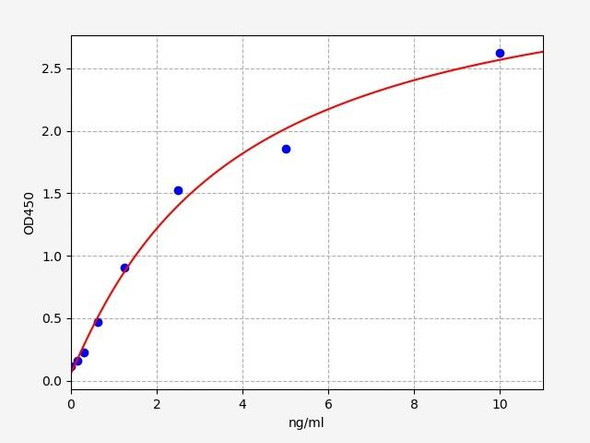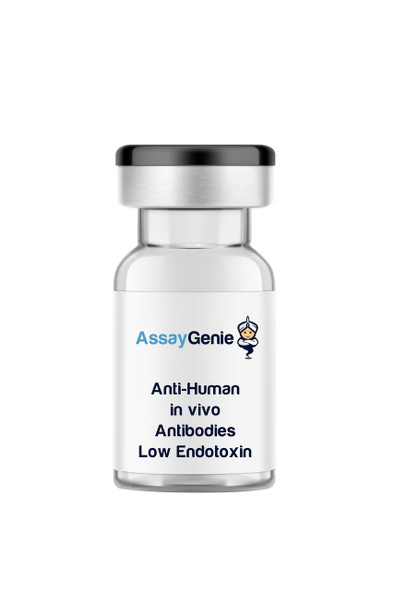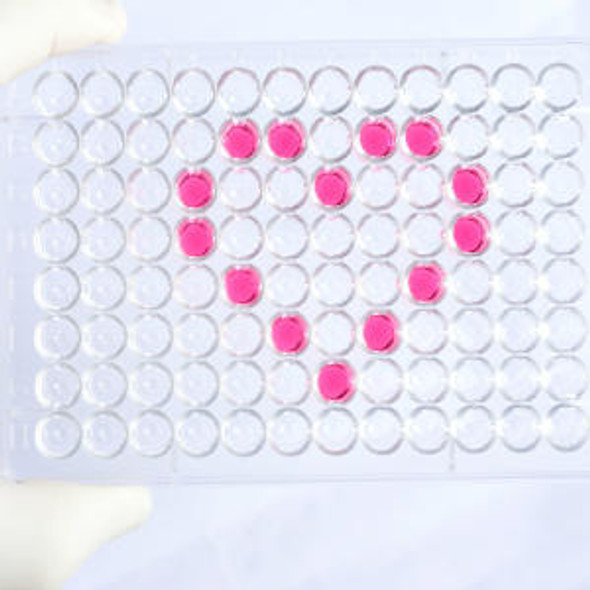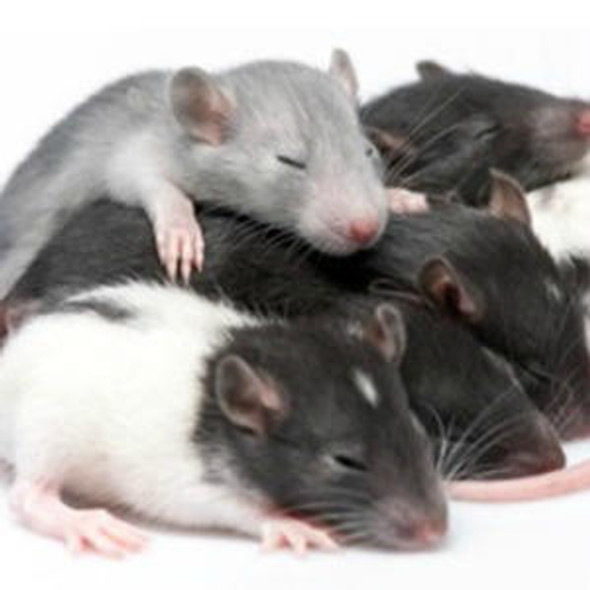Human CCR5 / CD195 ELISA Kit
- SKU:
- HUFI01743
- Product Type:
- ELISA Kit
- Size:
- 96 Assays
- Uniprot:
- P51681
- Sensitivity:
- 0.188ng/ml
- Range:
- 0.313-20ng/ml
- ELISA Type:
- Sandwich ELISA, Double Antibody
- Synonyms:
- CCR5, C-C chemokine receptor type 5, CD195, C-C CKR-5, C-C motif chemokine receptor 5, CCCKR, CCR-5, CD195 antigen, chemokine, C-C motif receptor 5, chemokine receptor CCR5, CHEMR13, chemr13, CKR5, CKR-5, HIV-1 fusion coreceptor, IDDM22CMKBR5
- Reactivity:
- Human
Description
| Product Name: | Human CCR5 / CD195 ELISA Kit |
| Product Code: | HUFI01743 |
| Size: | 96 Assays |
| Alias: | CCR5, C-C chemokine receptor type 5, CD195, C-C CKR-5, C-C motif chemokine receptor 5, CCCKR, CCR-5, CD195 antigen, chemokine, C-C motif receptor 5, chemokine receptor CCR5, CHEMR13, chemr13, CKR5, CKR-5, HIV-1 fusion coreceptor, IDDM22CMKBR5 |
| Detection method: | Sandwich ELISA, Double Antibody |
| Application: | This immunoassay kit allows for the in vitro quantitative determination of Human CCR5 concentrations in serum plasma and other biological fluids. |
| Sensitivity: | 0.188ng/ml |
| Range: | 0.313-20ng/ml |
| Storage: | 4°C for 6 months |
| Note: | For Research Use Only |
| Recovery: | Matrices listed below were spiked with certain level of Human CCR5 and the recovery rates were calculated by comparing the measured value to the expected amount of Human CCR5 in samples. | ||||||||||||||||
| |||||||||||||||||
| Linearity: | The linearity of the kit was assayed by testing samples spiked with appropriate concentration of Human CCR5 and their serial dilutions. The results were demonstrated by the percentage of calculated concentration to the expected. | ||||||||||||||||
| |||||||||||||||||
| CV(%): | Intra-Assay: CV<8% Inter-Assay: CV<10% |
| Component | Quantity | Storage |
| ELISA Microplate (Dismountable) | 8×12 strips | 4°C for 6 months |
| Lyophilized Standard | 2 | 4°C/-20°C |
| Sample/Standard Dilution Buffer | 20ml | 4°C |
| Biotin-labeled Antibody(Concentrated) | 120ul | 4°C (Protect from light) |
| Antibody Dilution Buffer | 10ml | 4°C |
| HRP-Streptavidin Conjugate(SABC) | 120ul | 4°C (Protect from light) |
| SABC Dilution Buffer | 10ml | 4°C |
| TMB Substrate | 10ml | 4°C (Protect from light) |
| Stop Solution | 10ml | 4°C |
| Wash Buffer(25X) | 30ml | 4°C |
| Plate Sealer | 5 | - |
Other materials and equipment required:
- Microplate reader with 450 nm wavelength filter
- Multichannel Pipette, Pipette, microcentrifuge tubes and disposable pipette tips
- Incubator
- Deionized or distilled water
- Absorbent paper
- Buffer resevoir
| Uniprot | P51681 |
| UniProt Protein Function: | CCR5: a 7-transmembrane G-linked receptor for a number of inflammatory C-C type chemokines including MIP-1-alpha, MIP-1-beta and RANTES. Transduces a signal by increasing the intracellular calcium ion level. May play a role in the control of granulocytic lineage proliferation or differentiation. Acts as a coreceptor (along with CD4) for HIV-1 R5 isolates. Interacts with PRAF2. Interacts with HIV-1 surface protein gp120. Efficient ligand binding to CCL3/MIP-1alpha and CCR4/MIP-1beta requires sulfation, O-glycosylation and sialic acid modifications. Glycosylation on S6 is required for efficient binding of CCL4. Interacts with ADRBK1. Interacts with ARRB1 and ARRB2. Variations in CCR5 are associated with resistance or susceptibility to immunodeficiency virus type 1 (resistance or susceptibility to HIV-1). Variations in CCR5 gene also influence the rate of progression to AIDS after infection. R60S variant, a naturally occurring mutation in a conserved residue in the first intracellular domain of CCR5, results in reduced amounts of the protein in the membrane and consequently may be associated with reduced susceptibility to infection by microbes that depend on these molecules as their receptors. Variations in CCR5 are associated with susceptibility to West Nile virus (WNV) infection |
| UniProt Protein Details: | Protein type:Receptor, GPCR; Motility/polarity/chemotaxis; Membrane protein, integral; Receptor, cytokine; Membrane protein, multi-pass; GPCR, family 1 Chromosomal Location of Human Ortholog: 3p21.31 Cellular Component: cell surface; integral to plasma membrane; cytoplasm; plasma membrane; endosome; external side of plasma membrane Molecular Function:protein binding; C-C chemokine receptor activity; chemokine receptor activity; coreceptor activity; C-C chemokine binding; actin binding; phosphoinositide phospholipase C activity Biological Process: viral reproduction; MAPKKK cascade; calcium-mediated signaling; release of sequestered calcium ion by sarcoplasmic reticulum into cytosol; chemotaxis; G-protein coupled receptor protein signaling pathway; elevation of cytosolic calcium ion concentration; cell surface receptor linked signal transduction; cell-cell signaling; calcium ion transport; dendritic cell chemotaxis; cellular defense response; immune response; entry into host cell; inflammatory response Disease: West Nile Virus, Susceptibility To; Diabetes Mellitus, Insulin-dependent, 22; Hepatitis C Virus, Susceptibility To |
| NCBI Summary: | This gene encodes a member of the beta chemokine receptor family, which is predicted to be a seven transmembrane protein similar to G protein-coupled receptors. This protein is expressed by T cells and macrophages, and is known to be an important co-receptor for macrophage-tropic virus, including HIV, to enter host cells. Defective alleles of this gene have been associated with the HIV infection resistance. The ligands of this receptor include monocyte chemoattractant protein 2 (MCP-2), macrophage inflammatory protein 1 alpha (MIP-1 alpha), macrophage inflammatory protein 1 beta (MIP-1 beta) and regulated on activation normal T expressed and secreted protein (RANTES). Expression of this gene was also detected in a promyeloblastic cell line, suggesting that this protein may play a role in granulocyte lineage proliferation and differentiation. This gene is located at the chemokine receptor gene cluster region. Two transcript variants encoding the same protein have been found for this gene. [provided by RefSeq, Jul 2008] |
| UniProt Code: | P51681 |
| NCBI GenInfo Identifier: | 1705896 |
| NCBI Gene ID: | 1234 |
| NCBI Accession: | P51681.1 |
| UniProt Secondary Accession: | P51681,O14692, O14693, O14695, O14696, O14697, O14698 O14699, O14700, O14701, O14702, O14703, |
| UniProt Related Accession: | P51681 |
| Molecular Weight: | 40,524 Da |
| NCBI Full Name: | C-C chemokine receptor type 5 |
| NCBI Synonym Full Names: | chemokine (C-C motif) receptor 5 (gene/pseudogene) |
| NCBI Official Symbol: | CCR5 |
| NCBI Official Synonym Symbols: | CKR5; CCR-5; CD195; CKR-5; CCCKR5; CMKBR5; IDDM22; CC-CKR-5 |
| NCBI Protein Information: | C-C chemokine receptor type 5; chemr13; HIV-1 fusion coreceptor; chemokine receptor CCR5; C-C motif chemokine receptor 5 A159A |
| UniProt Protein Name: | C-C chemokine receptor type 5 |
| UniProt Synonym Protein Names: | CHEMR13; HIV-1 fusion coreceptor; CD_antigen: CD195 |
| Protein Family: | C-C chemokine receptor |
| UniProt Gene Name: | CCR5 |
| UniProt Entry Name: | CCR5_HUMAN |
*Note: Protocols are specific to each batch/lot. For the correct instructions please follow the protocol included in your kit.
Before adding to wells, equilibrate the SABC working solution and TMB substrate for at least 30 min at 37°C. When diluting samples and reagents, they must be mixed completely and evenly. It is recommended to plot a standard curve for each test.
| Step | Protocol |
| 1. | Set standard, test sample and control (zero) wells on the pre-coated plate respectively, and then, record their positions. It is recommended to measure each standard and sample in duplicate. Wash plate 2 times before adding standard, sample and control (zero) wells! |
| 2. | Aliquot 0.1ml standard solutions into the standard wells. |
| 3. | Add 0.1 ml of Sample / Standard dilution buffer into the control (zero) well. |
| 4. | Add 0.1 ml of properly diluted sample ( Human serum, plasma, tissue homogenates and other biological fluids.) into test sample wells. |
| 5. | Seal the plate with a cover and incubate at 37 °C for 90 min. |
| 6. | Remove the cover and discard the plate content, clap the plate on the absorbent filter papers or other absorbent material. Do NOT let the wells completely dry at any time. Wash plate X2. |
| 7. | Add 0.1 ml of Biotin- detection antibody working solution into the above wells (standard, test sample & zero wells). Add the solution at the bottom of each well without touching the side wall. |
| 8. | Seal the plate with a cover and incubate at 37°C for 60 min. |
| 9. | Remove the cover, and wash plate 3 times with Wash buffer. Let wash buffer rest in wells for 1 min between each wash. |
| 10. | Add 0.1 ml of SABC working solution into each well, cover the plate and incubate at 37°C for 30 min. |
| 11. | Remove the cover and wash plate 5 times with Wash buffer, and each time let the wash buffer stay in the wells for 1-2 min. |
| 12. | Add 90 µl of TMB substrate into each well, cover the plate and incubate at 37°C in dark within 10-20 min. (Note: This incubation time is for reference use only, the optimal time should be determined by end user.) And the shades of blue can be seen in the first 3-4 wells (with most concentrated standard solutions), the other wells show no obvious color. |
| 13. | Add 50 µl of Stop solution into each well and mix thoroughly. The color changes into yellow immediately. |
| 14. | Read the O.D. absorbance at 450 nm in a microplate reader immediately after adding the stop solution. |
When carrying out an ELISA assay it is important to prepare your samples in order to achieve the best possible results. Below we have a list of procedures for the preparation of samples for different sample types.
| Sample Type | Protocol |
| Serum | If using serum separator tubes, allow samples to clot for 30 minutes at room temperature. Centrifuge for 10 minutes at 1,000x g. Collect the serum fraction and assay promptly or aliquot and store the samples at -80°C. Avoid multiple freeze-thaw cycles. If serum separator tubes are not being used, allow samples to clot overnight at 2-8°C. Centrifuge for 10 minutes at 1,000x g. Remove serum and assay promptly or aliquot and store the samples at -80°C. Avoid multiple freeze-thaw cycles. |
| Plasma | Collect plasma using EDTA or heparin as an anticoagulant. Centrifuge samples at 4°C for 15 mins at 1000 × g within 30 mins of collection. Collect the plasma fraction and assay promptly or aliquot and store the samples at -80°C. Avoid multiple freeze-thaw cycles. Note: Over haemolysed samples are not suitable for use with this kit. |
| Urine & Cerebrospinal Fluid | Collect the urine (mid-stream) in a sterile container, centrifuge for 20 mins at 2000-3000 rpm. Remove supernatant and assay immediately. If any precipitation is detected, repeat the centrifugation step. A similar protocol can be used for cerebrospinal fluid. |
| Cell culture supernatant | Collect the cell culture media by pipette, followed by centrifugation at 4°C for 20 mins at 1500 rpm. Collect the clear supernatant and assay immediately. |
| Cell lysates | Solubilize cells in lysis buffer and allow to sit on ice for 30 minutes. Centrifuge tubes at 14,000 x g for 5 minutes to remove insoluble material. Aliquot the supernatant into a new tube and discard the remaining whole cell extract. Quantify total protein concentration using a total protein assay. Assay immediately or aliquot and store at ≤ -20 °C. |
| Tissue homogenates | The preparation of tissue homogenates will vary depending upon tissue type. Rinse tissue with 1X PBS to remove excess blood & homogenize in 20ml of 1X PBS (including protease inhibitors) and store overnight at ≤ -20°C. Two freeze-thaw cycles are required to break the cell membranes. To further disrupt the cell membranes you can sonicate the samples. Centrifuge homogenates for 5 mins at 5000xg. Remove the supernatant and assay immediately or aliquot and store at -20°C or -80°C. |
| Tissue lysates | Rinse tissue with PBS, cut into 1-2 mm pieces, and homogenize with a tissue homogenizer in PBS. Add an equal volume of RIPA buffer containing protease inhibitors and lyse tissues at room temperature for 30 minutes with gentle agitation. Centrifuge to remove debris. Quantify total protein concentration using a total protein assay. Assay immediately or aliquot and store at ≤ -20 °C. |
| Breast Milk | Collect milk samples and centrifuge at 10,000 x g for 60 min at 4°C. Aliquot the supernatant and assay. For long term use, store samples at -80°C. Minimize freeze/thaw cycles. |










